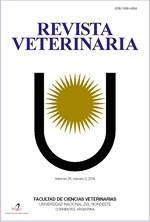Allopurinol and domperidone in the treatment of canine visceral leishmaniosis
DOI:
https://doi.org/10.30972/vet.3114613Keywords:
Canines, visceral leishmaniasis, allopurinol and domperidone, parasite charge, clinical and laboratory signsAbstract
In Argentina, human leishmaniosis treatment is regulated by means of the therapeutic scheme suggested by WHO and is provided by the government. The objective of this present work was to evaluate the progression of clinical signs, laboratory values and parasitic load at the beginning and during the progression of canine leishmaniasis, using a protocol that combined oral administration of allopurinol and domperidone as an alternative protocol of the standard pharmacological treatment. Ten dogs were admitted at the veterinary school hospital in Corrientes (Argentina), after clinical signs were evaluated. A comprehensive environmental and pharmacological therapeutic protocol was initiated by the combination of allopurinol and domperidone and a medical follow-up with clinical, laboratorial and parasitological parameters controls. All patients demonstrated a fast response to the treatment. The combination of allopurinol and domperidone shows favorable results, as long as adjustments are made according to clinical signs, biochemical profiles and the estimation of parasitic load. Although a higher number of cases as well as trial time are necessary, the results obtained from the protocol used in this assay, may indicate that it is an alternative that can be used in the pharmacological treatment of canine visceral leishmaniasis. Thus, it may be used as a tool for the epidemiological disease control..
Downloads
References
Baneth G, Shaw SE. 2002. Chemotherapy of canine leishmaniosis. Vet Parasitol 106: 315-324.
Cortadellas O. 2016. Tratamiento de la leishmaniosis canina. En: La leishmaniosis canina, una visión práctica, Ed. Sastre-Molina, Barcelona. p. 75-91.
Freeman ME, Kanyicska B, Lerant A, Nagy G. 2000. Prolactin: structure, function, and regulation of secretion. Physiol Rev 80: 1523-1631.
Gómez OP. 2004. Tesis doctoral: Estudio de un nuevo tratamiento
de la leishmaniosis canina. Valoración del efecto inmunomodulador de la domperidona, Facult. Vet. Univ. Zaragoza, https://zaguan.unizar.es, 212 p.
González LM, Vélez ID. 2006. Tratamiento con miltefosina de la leishmaniosis cutánea diseminada. Biomédica 26: 13-16.
Maddison JE, Page SW, Church DB. 2008. Small animal clinical pharmacology, 2nd. ed., Elsevier-Saunders, Edimburg, London, 589 p.
Martínez PP, Martínez IR, Méndez PP. 2012. Caracterización de la función renal en perros. Rev Med Vet 23: 73-82.
Matera L et al. 2000. Individual and combined effect of
granulocyte-macrophage colony-stimulating factor and prolactin on maturation of dendritic cells from blood monocytes under serum-free conditions. Immunology 100: 29-36.
Matera L, Mori M. 2000. Cooperation of pituitary hormone prolactin with interleukin-2 and interleukin-12 on production of interferon-gamma by natural killer and T cells. Ann N Y Acad Sci 917: 505-513.
Matera L, Mori M, Geuna M, Buttiglieri S, Palestro G. 2000. Prolactin in autoimmunity and antitumor defense. J Neuroimmunol 109: 47-55.
Noli C, Auxilia ST. 2005. Treatment of canine old world visceral leishmaniasis: A systematic review. Vet Dermatol 16: 213-232.
Paltrinieri S et al. 2010. Guidelines for diagnosis and clinical classification of Leishmaniasis in dogs. J Am Vet Med Assoc 236: 1184-1191.
Plevraki K et al. 2006. Efectos del tratamiento con allopurinol en la progresión de la nefritis crónica en la leishmaniosis canina. J Vet Intern Med 20: 228-233.
Robledo SM, Puerta JA, Muñoz DL, Guardo M, Vélez ID. 2006. Eficacia y tolerancia de la pentamidina en el tratamiento de la leishmaniasis cutánea producida por Leishmania panamensis en Colombia. Biomédica 26: 188-193.
Rougier S et al. 2008. Eficacia de diferentes regímenes de tratamiento de marbofloxacino en la leishmaniosis visceral
canina: un estudio piloto. Vet Parasitol 153: 244-254.
Rovensky J et al. 1995. Effect of domperidone-induced hyperprolactinemia on selected immune parameters in healthy women. Arch Immunol Ther Exp 43: 221-227.
Solano GL et al. 2011. Leishvet guidelines for the practical
management of canine leishmaniosis. Parasit Vectors 4: 86.
Soto J, Soto P. 2006. Miltefosina oral para el tratamiento de la leishmaniasis. Biomédica 26: 194-206.
Soto J, Soto P. 2006. Estado actual y futuro de la terapia anti-leishmaniásica en Colombia. Biomédica 26: 207-217.
Torres M et al. 2011. Long term follow-up of dogs diagnosed with leishmaniosis (clinical stage II) and treated with meglumine antimoniate and allopurinol. The Vet Journ 188: 346-351.
Torres M et al. 2016. Adverse urinary effects of allopurinol in dogs with leishmaniasis. J Small Anim Pract 57: 299-304.
Travi BL. 2014. Ethical and epidemiological dilemmas in the treatment of dogs for visceral leishmaniasis in Latin America. Biomédica 34: 7-12.
Downloads
Published
How to Cite
Issue
Section
License
Revista Veterinaria (Rev. Vet.) maintains a commitment to the policies of Open Access to scientific information, as it considers that both scientific publications as well as research investigations funded by public resources should circulate freely without restrictions. Revista Veterinaria (Rev. Vet.) ratifies the Open Access model in which scientific publications are made freely available at no cost online.










.jpg)
.jpg)



